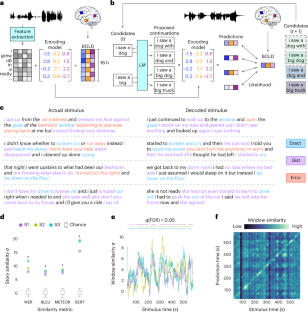2023-05-01 テキサス大学オースチン校(UT Austin)
このシステムは、脳卒中などにより身体的に話すことができないが、精神的には意識がある人々が再び賢明にコミュニケーションをとることを助ける可能性がある。
この研究成果は、Nature Neuroscience誌に掲載され、非侵襲的な手法であり、外科的なインプラントを必要としないため、他の言語デコーディングシステムとは異なっている。
<関連情報>
- https://news.utexas.edu/2023/05/01/brain-activity-decoder-can-reveal-stories-in-peoples-minds/
- https://www.nature.com/articles/s41593-023-01304-9
非侵襲的脳記録からの連続言語の意味的再構成 Semantic reconstruction of continuous language from non-invasive brain recordings
Jerry Tang,Amanda LeBel,Shailee Jain & Alexander G. Huth
Nature Neuroscience Published:01 May 2023
DOI:https://doi.org/10.1038/s41593-023-01304-9

Abstract
A brain–computer interface that decodes continuous language from non-invasive recordings would have many scientific and practical applications. Currently, however, non-invasive language decoders can only identify stimuli from among a small set of words or phrases. Here we introduce a non-invasive decoder that reconstructs continuous language from cortical semantic representations recorded using functional magnetic resonance imaging (fMRI). Given novel brain recordings, this decoder generates intelligible word sequences that recover the meaning of perceived speech, imagined speech and even silent videos, demonstrating that a single decoder can be applied to a range of tasks. We tested the decoder across cortex and found that continuous language can be separately decoded from multiple regions. As brain–computer interfaces should respect mental privacy, we tested whether successful decoding requires subject cooperation and found that subject cooperation is required both to train and to apply the decoder. Our findings demonstrate the viability of non-invasive language brain–computer interfaces.


